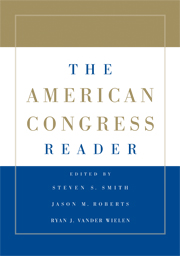Book contents
- Frontmatter
- Contents
- THE AMERICAN CONGRESS READER
- PART I THE AMERICAN CONGRESS: MODERN TRENDS
- PART II REPRESENTATION AND LAWMAKING IN CONGRESS: THE CONSTITUTIONAL AND HISTORICAL CONTEXT
- PART III CONGRESSIONAL ELECTIONS AND POLICY ALIGNMENTS
- 8 Elbridge Gerry's Salamander
- 9 Strategic Politicians and the Dynamics of U.S. House Elections, 1946–1986
- 10 Congress
- PART IV MEMBERS, GOALS, RESOURCES, AND STRATEGIES
- PART V PARTIES AND LEADERS
- PART VI THE STANDING COMMITTEES
- PART VII THE RULES OF THE LEGISLATIVE GAME
- PART VIII THE FLOOR AND VOTING
- PART IX CONGRESS AND THE PRESIDENT
- PART X CONGRESS AND THE COURTS
- PART XI CONGRESS, LOBBYISTS, AND INTEREST GROUPS
- PART XII CONGRESS AND BUDGET POLITICS
- PART XIII FURTHER READINGS ON CONGRESSIONAL POLITICS
8 - Elbridge Gerry's Salamander
The Electoral Consequences of the Reapportionment Revolution – Excerpts
Published online by Cambridge University Press: 05 June 2012
- Frontmatter
- Contents
- THE AMERICAN CONGRESS READER
- PART I THE AMERICAN CONGRESS: MODERN TRENDS
- PART II REPRESENTATION AND LAWMAKING IN CONGRESS: THE CONSTITUTIONAL AND HISTORICAL CONTEXT
- PART III CONGRESSIONAL ELECTIONS AND POLICY ALIGNMENTS
- 8 Elbridge Gerry's Salamander
- 9 Strategic Politicians and the Dynamics of U.S. House Elections, 1946–1986
- 10 Congress
- PART IV MEMBERS, GOALS, RESOURCES, AND STRATEGIES
- PART V PARTIES AND LEADERS
- PART VI THE STANDING COMMITTEES
- PART VII THE RULES OF THE LEGISLATIVE GAME
- PART VIII THE FLOOR AND VOTING
- PART IX CONGRESS AND THE PRESIDENT
- PART X CONGRESS AND THE COURTS
- PART XI CONGRESS, LOBBYISTS, AND INTEREST GROUPS
- PART XII CONGRESS AND BUDGET POLITICS
- PART XIII FURTHER READINGS ON CONGRESSIONAL POLITICS
Summary
Cox and Katz argue that the massive wave of redistricting that occurred post-1964 created an “incumbency advantage” in the U.S. House. They find that the political composition of the courts and state legislatures that redrew the districts are critical to understanding which party benefited from redistricting. On balance, they find that the redistricting created a larger advantage for Republican incumbents.
THE REAPPORTIONMENT REVOLUTION
A Sketch of the Reapportionment Revolution
The Court's Decisions
On March 26, 1962, the Supreme Court handed down its decision in the case of Baker v. Carr, thus initiating what has since been known as the reapportionment revolution. The suit was brought by urban plaintiffs in Tennessee, who challenged their state legislature's failure to reapportion despite widespread population shifts that had made urban districts vastly more populous than their rural counterparts. The ramifications of the case were clearly national, because urban and especially suburban Americans were significantly underrepresented in state legislatures throughout the country. Thus, although the Court limited itself to declaring that state legislative reapportionment was justiciable, leaving more specific action in the case to the lower courts, its decision was immediately seen as a revolutionary step – one the Court had repeatedly declined to take.
The immediate consequence of Baker was more litigation. Indeed, within a year of the decision, all but 14 states were involved in reapportionment suits, and the Supreme Court used some of these cases to stake out a clearer substantive position.
- Type
- Chapter
- Information
- The American Congress Reader , pp. 101 - 112Publisher: Cambridge University PressPrint publication year: 2008

